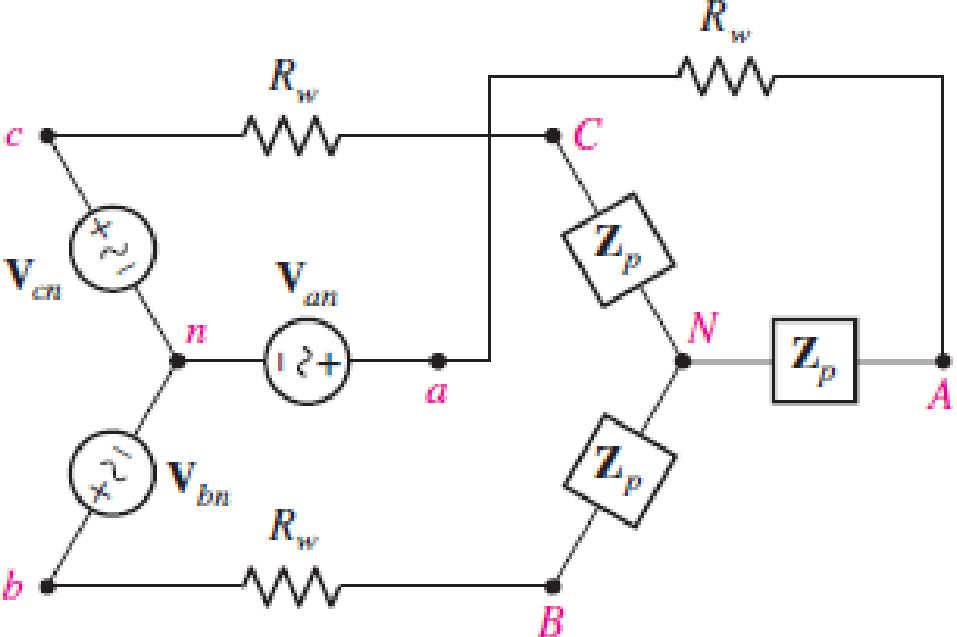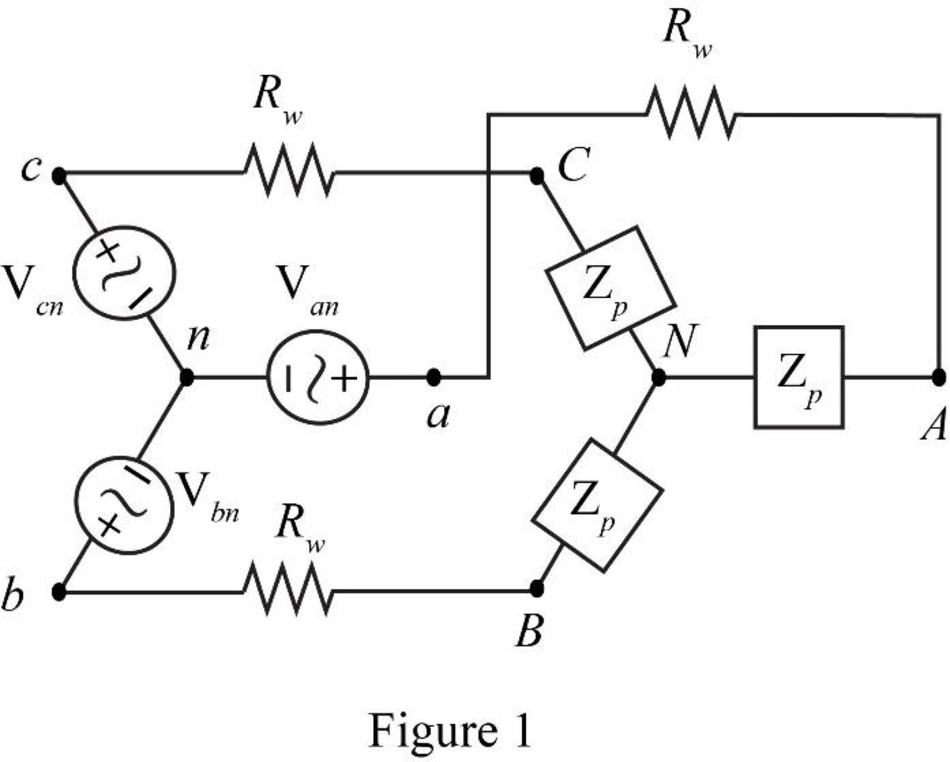
Concept explainers
Assume the system shown in Fig. 12.34 is balanced, Rw = 0,  , and a positive phase sequence applies. Calculate all phase and line currents, and all phase and line voltages, if Zp is equal to (a) 1 kΩ; (b) 100 + j48 Ω; (c) 100 − j48 Ω.
, and a positive phase sequence applies. Calculate all phase and line currents, and all phase and line voltages, if Zp is equal to (a) 1 kΩ; (b) 100 + j48 Ω; (c) 100 − j48 Ω.

(a)
All the line and phase currents and all the line and phase voltages for the given load impedance.
Answer to Problem 17E
The line and phase currents in sequence are
Explanation of Solution
Given data:
The resistance of the wire
The phase to neutral voltage
The load impedance
Calculation:
The system follows positive sequence hence the phase to neutral voltages will be,
For phase
For phase
The required diagram is shown in Figure 1.

The line voltage between phase
Substitute
The system follows positive sequence hence the line to line voltages will be,
All the phase and line voltages are independent of the impedance value and hence these values will remain same for all the values of load impedance
The conversion from
Hence, the load impedance
Since the given system is a star connected system, the phase currents will be equal to the line currents.
The phase
Here,
The phase
Substitute
The phase
Here,
The phase
Substitute
The phase
Here,
The phase
Substitute
Conclusion:
Therefore, the line and phase currents in sequence are
(b)
All the line and phase currents and all the line and phase voltages for the given load impedance.
Answer to Problem 17E
The line and phase currents in sequence are
Explanation of Solution
Given data:
The load impedance
Calculation:
All the phase and line voltages are independent of the impedance value and hence these values will remain same for all the values of load impedance
The phase
Here,
The phase
Substitute
The phase
Here,
The phase
Substitute
The phase
Here,
The phase
Substitute
Conclusion:
Therefore, the line and phase currents in sequence are
(c)
All the line and phase currents and all the line and phase voltages for the given load impedance.
Answer to Problem 17E
The line and phase currents in sequence are
Explanation of Solution
Given data:
The load impedance
Calculation:
All the phase and line voltages are independent of the impedance value and hence these values will remain same for all the values of load impedance
The phase
Here,
The phase
Substitute
The phase
Here,
The phase
Substitute
The phase
Here,
The phase
Substitute
Conclusion:
Therefore, the line and phase currents in sequence are
Want to see more full solutions like this?
Chapter 12 Solutions
Engineering Circuit Analysis
- Please solve in detailarrow_forward6.7 The transmitting aerial shown in Fig. Q.3 is supplied with current at 80 A peak and at frequency 666.66 kHz. Calculate (a) the effective height of the aerial, and (b) the electric field strength produced at ground level 40 km away. 60 m Fig. Q.3 Input 48 m Eartharrow_forwardox SIM 12.11 Consider the class B output stage, using MOSFETs, shown in Fig. P12.11. Let the devices have |V|= 0.5 V and μC WIL = 2 mA/V². With a 10-kHz sine-wave input of 5-V peak and a high value of load resistance, what peak output would you expect? What fraction of the sine-wave period does the crossover interval represent? For what value of load resistor is the peak output voltage reduced to half the input? Figure P12.11 +5 V Q1 Q2 -5Varrow_forward
- 4 H ་་་་་་་ 四一周 A H₂ Find out put c I writ R as a function G, H, Harrow_forward4 H A H₂ 四一周 Find out put c I writ R as a function G, H, Harrow_forward8. (a) In a Round-Robin tournament, the Tigers beat the Blue Jays, the Tigers beat the Cardinals, the Tigers beat the Orioles, the Blue Jays beat the Cardinals, the Blue Jays beat the Orioles and the Cardinals beat the Orioles. Model this outcome with a directed graph. https://www.akubihar.com (b) (c) ✓ - Let G = (V, E) be a simple graph. Let R be the relation on V consisting of pairs of vertices (u, v) such that there is a path from u to vor such that u= v. Show that R is an equivalence relation. 3 3 Determine whether the following given pair of directed graphs, shown in Fig. 1 and Fig. 2, are isomorphic or not. Exhibit an isomorphism or provide a rigorous argument that none exists. 4+4=8 Աշ աշ ИНИЯ Fig. 1 Fig. 2 Querarrow_forward
- EXAMPLE 4.5 Objective: Determine ID, circuit. V SG' SD Vs and the small - signal voltage gain of a PMOS transistor Consider the circuit shown in Figure 4.20(a). The transistor parameters are A K = 0.80m- V Р _2’TP = 0.5V, and λ = 0 Varrow_forwardNeed a solution and don't use chatgptarrow_forwardNeed a solarrow_forward
 Introductory Circuit Analysis (13th Edition)Electrical EngineeringISBN:9780133923605Author:Robert L. BoylestadPublisher:PEARSON
Introductory Circuit Analysis (13th Edition)Electrical EngineeringISBN:9780133923605Author:Robert L. BoylestadPublisher:PEARSON Delmar's Standard Textbook Of ElectricityElectrical EngineeringISBN:9781337900348Author:Stephen L. HermanPublisher:Cengage Learning
Delmar's Standard Textbook Of ElectricityElectrical EngineeringISBN:9781337900348Author:Stephen L. HermanPublisher:Cengage Learning Programmable Logic ControllersElectrical EngineeringISBN:9780073373843Author:Frank D. PetruzellaPublisher:McGraw-Hill Education
Programmable Logic ControllersElectrical EngineeringISBN:9780073373843Author:Frank D. PetruzellaPublisher:McGraw-Hill Education Fundamentals of Electric CircuitsElectrical EngineeringISBN:9780078028229Author:Charles K Alexander, Matthew SadikuPublisher:McGraw-Hill Education
Fundamentals of Electric CircuitsElectrical EngineeringISBN:9780078028229Author:Charles K Alexander, Matthew SadikuPublisher:McGraw-Hill Education Electric Circuits. (11th Edition)Electrical EngineeringISBN:9780134746968Author:James W. Nilsson, Susan RiedelPublisher:PEARSON
Electric Circuits. (11th Edition)Electrical EngineeringISBN:9780134746968Author:James W. Nilsson, Susan RiedelPublisher:PEARSON Engineering ElectromagneticsElectrical EngineeringISBN:9780078028151Author:Hayt, William H. (william Hart), Jr, BUCK, John A.Publisher:Mcgraw-hill Education,
Engineering ElectromagneticsElectrical EngineeringISBN:9780078028151Author:Hayt, William H. (william Hart), Jr, BUCK, John A.Publisher:Mcgraw-hill Education,





